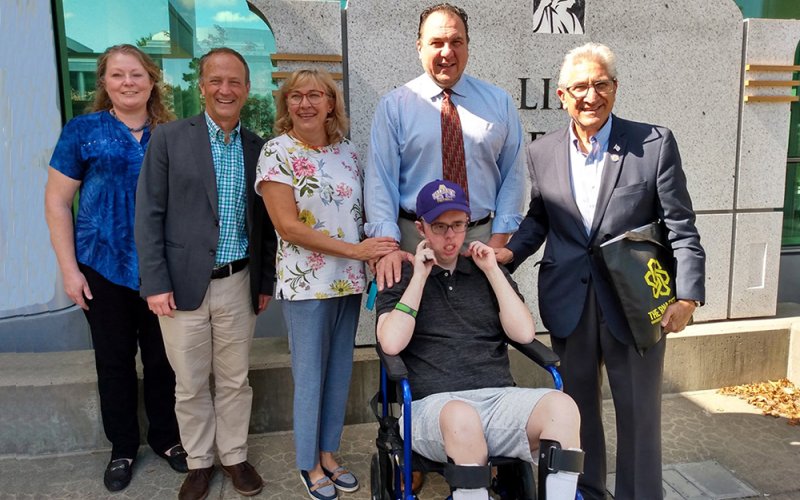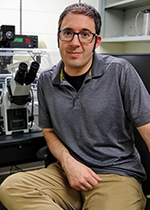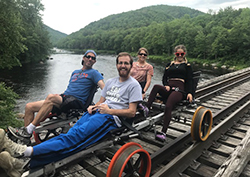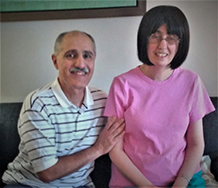The RNA Institute Builds Friendships as it Battles Myotonic Dystrophy

ALBANY, N.Y. (Feb. 1, 2022) — Since Andy Berglund’s arrival as director of the RNA Institute in 2018, family and community have gone hand in hand with discovery.
Family, in fact, had a lot to do with Berglund’s choice in 2002 to devote much of his RNA biochemical research to neurodegenerative diseases, and in particular myotonic dystrophy (DM). One of Berglund’s undergraduate students at the University at Oregon in 2002 was Jeremy Logue, now an associate professor in the Department of Regenerative and Cancer Cell Biology at Albany Medical Center.

“Jeremy, whose mother had adult-onset DM, introduced me to myotonic dystrophy and was the catalyst for my lab’s focus on DM research,” said Berglund.
Recalled Logue, “As an undergraduate researcher and later as a technician for a year before leaving for graduate school, I, Andy and postdoctoral fellow Blaine Mooers determined the atomic structure of the RNA triplet repeat that leads to DM.” Their paper was published in 2005, 2 years after Logue’s mother, Cheryl Ann, passed away from DM. The Berglund lab’s first DM publication was dedicated to her memory.
“I feel very lucky now to have Andy and the RNA Institute close by, and I will continue to advocate for the important work that is being done at the Institute,” Logue said.
Lori Planco, a senior research analyst in Biology at UAlbany, also has a family connection to the Institute’s research. Her two children, now 22 and 27, have juvenile onset DM, and her husband has adult onset DM.
Planco, who lives part time in Florida, connected with Berglund when he was a professor at the University of Florida, Gainesville, and she started a volunteer internship in bioinformatics in his lab. “About one year later, in October of 2018, when Andy was moving to Albany, he asked me if I wanted to continue working in bioinformatics and offered me a part-time position.”

A financial supporter of DM research, first at UF and now to aid the RNA Institute, she said that “providing a donation to further the science is important to us. Since it’s an orphan disease, funding doesn’t seem very easy, and capturing the attention of younger students is important to keep discovering new ways to cure the disorder.”
A recent addition to the Institute’s support team is the Capital Region’s Genzano family — Emilio and Jill, whose son Joey has DM. They were all at the Life Science Research Building on Sept. 15 to commemorate International Myotonic Dystrophy Awareness Day and lend support for the Institute's fight against the disorder.
“Emilio has been amazing at getting various government connections of his to come do tours of the RNA Institute and/or lobbying for more awareness for DM,” said Berglund. “His family has founded a large network of colleagues, friends and donors to support DM research, and we are hoping that, with their help, a fundraising event can be held here this year.”

Researcher Hormoz Mazdiyasni joined the Institute less than two years ago. His wife Hida has DM. “They moved from outside the Boston area — leaving MIT to join us,” said Berglund. “It has been wonderful having Hormoz in the Institute, as he brings expertise in medicinal chemistry — which we were lacking — from his 29 years in the pharma/biotech industry. He is working on making novel small molecules that have the potential to be developed into a drug for DM.”
Connections of family and friendship brought another strong supporter, Maryphena Peabody. Two of her three children, Hannah and Ada, are afflicted since birth by another genetic disease affecting motor function, spinocerebellar ataxia type 8 (SCA8). Seeking information on treatment, the family made frequent visits to the Center for Neurogenetics at UF, where Hannah and Ada became part of SCA8 research studies.
They eventually became friends with Tammy Reid, a lab manager at the center and now the RNA Institute’s research development manager. Soon after, they met Berglund, then the lead researcher in the UF lab studying DM. Four years later, Berglund and Reid had come to the Institute. Unrelated and prior to this, Maryphena and Hannah had moved to the Albany area.
“We soon made the connection that Tammy Reid was living in the Capital Region,” said Peabody. A reunion meeting led to a visit to the institute and Berglund’s lab, where, she said, they met researchers diligently working to “understand the function of aberrant/rogue RNA bits” that could lead to cures that would impact both DM and SCA8. “There is no price we can place on the importance of this research,” she said.
Important also, she said, “on a very personal level, the human connection at the RNA Institute enhances and enriches all of our personal and professional lives. I don’t know a lot about research labs, but I get the impression that the researchers do not always take a keen interest in the human side of their research.
“Andy Berglund’s approach is different. His passion for this work, and the community affected by it, spills out to his researchers in this very personal way, creating a family feel between these two sides of the same tribe, which is invaluable to me and my family.”




